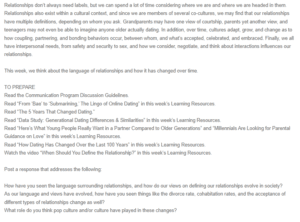The Evolution of Relationships
The language surrounding relationships and people’s views on defining their relationships have evolved significantly over time, reflecting changes in societal norms, cultural influences, and individual preferences. Some of the significant aspects of this evolution include traditional relationship terminology. In the past, relationships were categorized in traditional and strict roles such as marriage and were accepted as the only acceptable form of a committed relationship (Markarian, n.d.). This is not the case today; some couples prefer not to get married at all but still stay together. Secondly, new relationship structures, open and polyamorous relationships, have emerged. Non-monogamous relationships, such as open or polyamorous relationships, have gained more recognition and acceptance in recent years (Jeet, 2018). This shift in societal attitudes has led to new terminology like “primary partner,” “secondary partner,” and “metamour” (partner’s partner) to describe the dynamics within these relationships.
Thirdly, dating was a one-way ticket to getting married; however, with the advent of online dating and technology, dating has become less serious and more about casual relationships. Further, the boundary between casual and committed relationships has become more fluid. Terms like “friends with benefits,” “situationship,” and “hooking up” are used to describe different levels of emotional and physical involvement in relationships (Fetters, 2018). The evolution in relationships and changing societal norms have significantly impacted divorce rates, cohabitation rates, and the acceptance of different types of relationships. For one, while the evolution of relationship dynamics has led to greater acceptance of diverse types of relationships, it has also contributed to changing views on marriage. Some individuals may delay marriage or opt for alternative relationship structures, which can affect divorce rates.
Secondly, cohabitation before marriage has become more common, allowing couples to test their compatibility and work through relationship issues before committing to marriage. This can lead to more stable and enduring marriages when they occur, potentially reducing divorce rates in some cases. In addition, there is an increase in the acceptance of non-traditional relationships. However, acceptance of such relationships as open marriages and polyamorous partnerships can lead to more complex dynamics and potentially increase the likelihood of relationship transitions, including separations and divorces. These non-traditional relationships may have unique challenges that impact stability.
Pop culture and culture play significant roles in the evolution of relationships in several ways. They can influence people’s attitudes, behaviors, and expectations in romantic and interpersonal relationships. Some of the key aspects of how pop culture and culture influence relationships include shaping relationship expectations, challenging stereotypes, examining cultural shifts, reflecting contemporary issues, and influencing social norms.
References
Fetters, A. (2018). The 5 years that changed dating. The Atlantic. https://www.theatlantic.com/family/archive/2018/12/tinder-changed-dating/578698/
Jeet D. (2018). Data study: Generational dating differences & similarities. The DateMix. https://www.zoosk.com/date-mix/dating-data/generational-dating-differences/
Markarian, T. (n.d.). How dating has changed over the last 100 years. The List. https://www.thelist.com/62575/dating-changed-last-100-years/
ORDER A PLAGIARISM-FREE PAPER HERE
We’ll write everything from scratch
Question

The Evolution of Relationships
Relationships don’t always need labels, but we can spend a lot of time considering where we are and where we are headed in them. Relationships also exist within a cultural context, and since we are members of several co-cultures, we may find that our relationships have multiple definitions, depending on whom you ask. Grandparents may have one view of courtship, parents yet another view, and teenagers may not even be able to imagine anyone older actually dating. In addition, over time, cultures adapt, grow, and change as to how coupling, partnering, and bonding behaviors occur, between whom, and what’s accepted, celebrated, and embraced. Finally, we all have interpersonal needs, from safety and security to sex, and how we consider, negotiate, and think about interactions influences our relationships.
This week, we think about the language of relationships and how it has changed over time.
TO PREPARE
Read the Communication Program Discussion Guidelines.
Read “From ‘Bae’ to ‘Submarining,’ The Lingo of Online Dating” in this week’s Learning Resources.
Read “The 5 Years That Changed Dating.”
Read “Data Study: Generational Dating Differences & Similarities” in this week’s Learning Resources.
Read “Here’s What Young People Really Want in a Partner Compared to Older Generations” and “Millennials Are Looking for Parental Guidance on Love” in this week’s Learning Resources.
Read “How Dating Has Changed Over the Last 100 Years” in this week’s Learning Resources.
Watch the video “When Should You Define the Relationship?” in this week’s Learning Resources.
Post a response that addresses the following:
How have you seen the language surrounding relationships, and how do our views on defining our relationships evolve in society?
As our language and views have evolved, how have you seen things like the divorce rate, cohabitation rates, and the acceptance of different types of relationships change as well?
What role do you think pop culture and/or culture have played in these changes?

